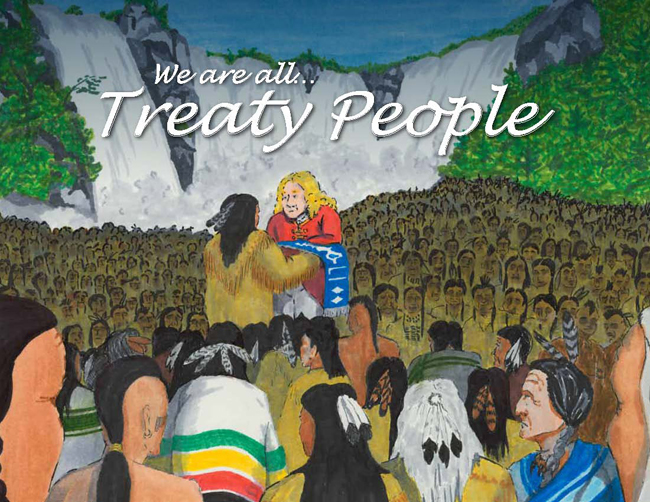First Nations commemorate 250th Treaty of Niagara anniversary with two-day event

First Nation leaders, Elders and citizens from across the region will gather along the Niagara River for two days to commemorate, celebrate and discuss the 250th Anniversary of the Treaty of Niagara.
To mark the 250th anniversary of the signing of this Treaty there will be a gathering of representatives of the Indigenous Nations which negotiated a Treaty of Peace with Sir William Johnson on behalf of Great Britain.
The 1764 Treaty of Fort Niagara was signed by Sir William Johnson for the Crown and 24 Nations from the Six Nations, Seneca, Wyandot of Detroit, Menominee, Algonquin, Nipissing, Ojibwa, Mississaugas, and others who were part of the Seven Nations of Canada and the Western Lakes Confederacy. The Treaty was concluded on August 1, 1764.
(This was a second treaty just with the Senecas. The treaty transferred possession of a narrow four mile strip of land along the Niagara River’s western shore. This Treaty also detached some of them from Pontiac’s Rebellion.)
This Treaty is significant as it reaffirmed the political foundation for the Covenant Chain Relations between Great Britain and the Indigenous Nations of the Great Lakes and Northeastern Woodlands. It also gauranteed the Indigenous Nations of an annual flow of goods and presents to ensure that the ongoing treaty was still valid. At the 1764 gathering were at least 24 Native Nations including the Seneca, Cayuga, Onondaga, Oneida, Mohawk, and Tuscarora of the Haudenosaunee Confederacy; Akwesasne, Kahnawake, Kahnasatake, and others of the Seven Nations of Canada; Wyandot of Detroit; Algonquin, Nipissing, Mississauga, Odawa, Ojibway and other Anishinaabe Nations; Menominee, and others who were part of the Western Lakes Confederacy.
“The 1764 Treaty was an important turning point in relationships between the Indigenous Nations that participated as it was a way of renewing their treaty relationship with each other, and refreshing the pledges made with the ancient Dish With One Spoon Treaty whereby the Indigenous Nations agreed to share the bounty provide by the Mother Earth,” said organizer and historian Rick Hill. “Increasing competition over the fur trade caused much strife between the Indigenous Nations. This commemoration is a form of healing of those old wounds.”
Events include a display of replicas of the various wampum belts that were held by Sir William Johnson at Fort Niagara at that time. Documentary evidence speaks of a belts hung on the walls in the Commandants quarters.
In addition to the speakers, there will be a gathering of the representatives and songs offered to honour the ancestors and celebrate the making of peace. People are asked to wear their traditional clothes and join in a dance to honour this Treaty. This will be followed by light refreshments. Please bring a dish of food to share.
In addition to the this event, there will be a second gathering on August 2, 2014 across the river at Fort George, at the site of the old Indian Council House that stood from 1797 to 1828. This is the where the King’s Fire had been transferred from Fort Niagara after the American Revolution. The Six Nations Legacy Consortium and Parks Canada have been collaborating on creating a raised bed garden that will mark the foot print of the old council house, and have been active an bring Native youth to this site to learn more about this history of this place.
Prior to and during the War of 1812 many treaty council meetings were held here, some attended by several thousand people. This was the place where the annual presents from the Crown were distributed. It is also the location where the end of the War of 1812 was concluded and a special ceremony took place in August 1815 to bring an end to animosities between Indigenous Nations that had been created by that war. So it is fitting location for the descendants of those that gathered here in the past to meet once again and rekindle their treaty relationships, cultural ties and shared history.
This summer Indigenous youth from across Ontario will experience the historic site of the Council House and tour nearby Fort George. Working with Mohawk College of Hamilton, the youth will work with Mohawk architect William Woodworth to help in making scale models of the Council House.
The August 2 gathering will introduce the Indigenous Nations representatives who attend the previous day commemoration to the site, and open up the dialogue on the meaning of our Covenant Chain Relationship. The Six Nations Legacy Consortium will provide a historical overview of the site and invite leaders, Elders and historians to share what they understand about the workings of the King’s Fire that was kindled here.
Agenda for the event can be seen here http://www.chiefs-of-ontario.org/sites/default/files/event-docs/AGENDA%20-%20DRAFT5.pdf


